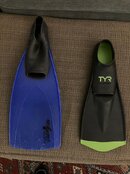MECindylou
New
Hello and help! I'm leaving Tuesday on a snorkel trip to Raja Ampat and am having second thoughts about the fins I'm planning to bring. I have an old pair of Sea Quest fins, but got a pair of TYR Flex fins (rubber) because they seemed pretty comfortable and, when I tried them in a small pool, felt like I had good control, maybe even better than my old ones. (My feet are small and I was having trouble finding any that fit.) Also, they're a bit smaller and I figured they'd pack well. Then I read some reviews and they all indicated that these fins are used for swim training to strengthen the foot. No mention of snorkeling or diving in any reviews. The folks at the dive shop seemed to think they were a fine choice; one woman said she'd used them on a dive trip. Would love thoughts of anyone who's familiar with them. Alternatively, I can take my old tried-and-true fins; they're not the most up to date, but I know they'll be okay.
Maybe I'm overthinking.
Thanks!
Maybe I'm overthinking.
Thanks!





